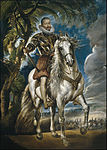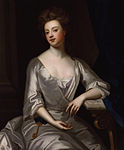Gunstling


En gunstling eller en favorit är en person som särskilt favoriseras, utmärks och gynnas av en makthavare framför andra, på grund av makthavarens personliga sympati och tycke för denna snarare än för faktiska meriter, och som genom makthavaren utvinner fördelar och ibland även politisk makt och inflytande. Begreppet har särskilt använts för personer vid kungliga hov under tidigmodern tid – från 1500- till 1700-talet.[1]
En gunstling utsattes ofta för avundsjuka och ifrågasattes, i synnerhet om han eller hon uppfattades som en ”uppkomling”. En bidragande orsak var att gunstlingen ofta uppfattades nå en inflytelserik ställning utan att ha förtjänat det, eftersom han eller hon ansågs nå denna av känslomässiga skäl snarare än faktiska meriter. Karaktäristiskt för gunstlingen är att denna inte sällan kommer långt in i makthavarens privata sfär. Gunstlingen drabbades ibland hårt när monarken dött eller störtats.
Uttrycket används främst om personer som inte hade ett sexuellt förhållande med makthavaren, eller i varje fall inte ett öppet sådant: en person som öppet hade en sexuell relation med en makthavare, och gynnades av denna orsak, kategoriserades snarare som en mätress eller älskare än som en gunstling.
Exempel
- Gustaf Mauritz Armfelt. gunstling åt Gustaf III
- Henri Coiffier de Ruzé d'Effiat, markis av Cinq-Mars, gunstling åt Ludvig XIII av Frankrike
- Marie Anne de La Trémoille, gunstling åt Maria Lovisa av Savojen
- Sarah Churchill, hertiginna av Marlborough, gunstling åt Anna av Storbritannien
- Grigori Rasputin, gunstling åt Nikolaj II av Ryssland
Galleri
Se även
Källor
- ^ J.H. Elliott and LWB Brockliss, eds, The World of the Favourite,1999, Yale UP, ISBN 0-300-07644-4
Media som används på denna webbplats
Författare/Upphovsman: George E. Koronaios, Licens: CC BY-SA 4.0
Portrait bust of Antinous. Thasian marble. Found at Patras. The youth Antinous of Bithynia, in Asia Minor was the favourite of the emperor Hadrian. After he drowned in the river Nile in A.D. 130, Hadrian had him deified and erected numerous statues, busts and portraits of him in cities and sanctuaries throughout the Roman empire. A.D. 130-138. Accession number: 417. National Archaeological Museum of Athens. Athens, Greece. Text: Museum inscription.
Sarah Churchill, Duchess of Marlborough, by Sir Godfrey Kneller, Bt (died 1723). See source website for additional information.
This set of images was gathered by User:Dcoetzee from the National Portrait Gallery, London website using a special tool. All images in this batch have been confirmed as author died before 1939 according to the official death date listed by the NPG.Författare/Upphovsman: Militärhistorikern, Licens: CC BY-SA 4.0
Porträtt av Gustaf Mauritz Armfelt av den österrikiske konstnären Josef Maria Grassi (1757-1838). Porträttet kom till under perioden 1799-1801.
Thought to be a later copy of a lost painting by Rubens, the work had hung on public display in the dinning room of Pollok House. A technique called dendrochronology, used to examine the tree rings of the wood, dated the panel to be from the 1620s and further technical analysis revealed the panel on which the portrait was painted had been prepared in the same way as was custom in Rubens’ studio.
Ben van Beneden, director of the Rubenshuis in Antwerp, authenticated the painting of George Villiers, the 1st Duke of Buckingham, confirming it to be by the Flemish artist. After centuries of dirt and overpainting was cleaned off by restorer Simon Gillespie the piece revealed many of Ruben’s trademark techniques. (Extracted from [1]).Retrato ecuestre de Gaspar de Guzmán y Pimentel (1587-1645), conde-duque de Olivares y valido del rey Felipe IV de España hasta que cayó en desgracia en 1643.
"Equestrian Portrait of the Duke of Lerma".











